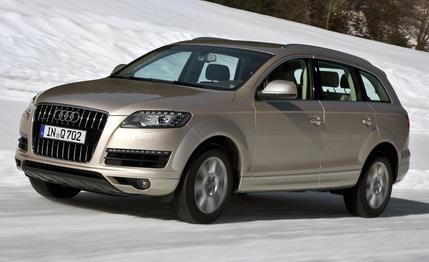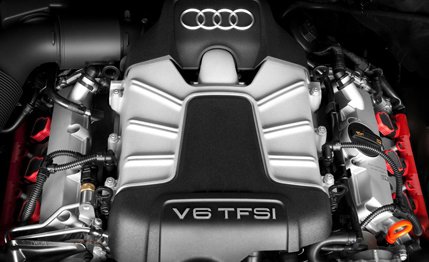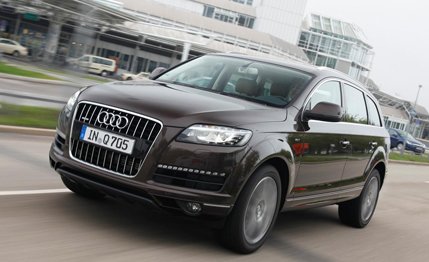 First Drive Review
First Drive Review
As the auto industry starts the great engine shrink-down in preparation for new fuel-economy standards, Audi has been perhaps the strategy’s most visible proponent. To that end, the 2011 Q7 sport-utilities headed to the U.S. will drop their big iron, the 3.6-liter V-6 and the 4.2-liter V-8, in favor of two versions of the company’s relatively new 3.0-liter supercharged V-6 making 272 hp or 333 hp. Behind the six sits the new A8’s eight-speed automatic with a broad ratio spread for better mileage. On a recent trip to Munich, we pounded the autobahn in the new Q7 and found nothing lacking.
Already installed in the A6 and S4, the 3.0 TFSI, as Audi calls it, is rapidly becoming the company’s gasoline workhorse in its medium-to-larger-size vehicles. The main features are an aluminum block that weighs just 73 pounds and displaces 2995 cc, and benzindirekteinspritzung, or direct fuel injection. The Roots-type twin-screw intercooled supercharger that mounts in the vee is relatively small at a displacement volume of 2.0 liters, which Audi says helps deliver the fast, seamless ramp-up in torque—a critical element if you hope to sell V-8 buyers on a V-6. Boost pressure peaks at 11.6 psi.
The eight-speed automatic already has debuted on the A8 sedan and will make its way into many more Audis this fall. The gear case is slightly longer than the old six-speed’s, but because the torque converter is thinner, the overall length is shorter and weight is down by 25 pounds. Audi says the Q7 will have a ratio spread of 7.3:1. On the current six-speed, the ratio spread is 6.0:1, a difference Audi says is alone worth about five percent in fuel economy. The current 3.0-liter TDI diesel V-6 will remain in the lineup, but paired with the new eight-speed auto.
Two ’Charging Levels

Audi has long used a sort of hidden control knob to vary the power between two otherwise identical engines, and the same is true in the 3.0 TFSI. The differing power outputs of the two U.S. versions—both of which will be labeled “3.0T Supercharged”—are mainly down to software. Compared with the engines the 3.0T replaces, the power picture remains roughly static, although there are some losses and gains on both sides.
The low-power 3.0T makes 272 hp and 295 lb-ft of torque; the 3.6-liter it replaces made 280 hp and 266 lb-ft. The hi-po 3.0T makes 333 hp and 325 pound-feet versus the 4.2-liter V-8’s 350 hp and 325 lb-ft. Fuel economy, which is 13 mpg city and 18 highway with the 4.2, could rise to as high as 16/21 in the 3.0T when final numbers are announced.
Audi claims the higher-output Q7 3.0T will hit 60 mph in “under 7.0 seconds”; the last Q7 4.2 we tested hit 60 in 7.5, and the 3.6 did it in 7.9. We’re hoping for better or at least similar performances once we get our test gear aboard the two 3.0Ts. What we can say is this: On the unrestricted sections of the Munich-to-Ingolstadt autobahn, the speed in the middle lane often is 80 mph and the left lane more like 120, so acceleration is critical. Jump out in front of a fast-moving Bavarian without the necessary power to rapidly come up to speed, and in the best case you’ll get an angry headlight flash. In the worst case, there will be a crash that leaves behind only really, really small pieces.
The 333-hp Q7 3.0T acquits itself well, darting into the supersonic lane with a rapid kickdown of the eight-speed transmission and enough grunt to prevent being lasered by fast-approaching high-beams. The supercharged V-6 is mostly a quiet hummer, but when you give it the boot, it sounds the business, emitting the same husky rumble of the S4 only a bit more muted. Owners of the 4.2 will hardly notice a difference. The low-power V-6 is, well, slower, but otherwise pretty much the same. Make sure the onrushing Bavarians are farther back before attempting the autobahn’s passing lane.

Audi may be the first to drop a V-8 from its big SUV, but others could soon follow. At the moment, BMW is sticking with its inline-six/V-8 strategy in the X5, and Mercedes has two V-8s and a diesel in its GL, but if Audi can woo V-8 buyers with a high-horsepower V-6, it’s sure to set a pattern for an industry hungry for fuel-economy gains.